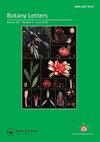Plant–insect interactions from the mid-Cretaceous at Puy-Puy (Aquitaine Basin, western France) indicates preferential herbivory for angiosperms amid a forest of ferns, gymnosperms, and angiosperms
IF 1.3
4区 生物学
Q3 PLANT SCIENCES
引用次数: 3
Abstract
ABSTRACT Plants and insects are the two dominant groups in terrestrial ecosystems, and insect damage on fossil plants is the only direct evidence documenting the past ecological history between these two, hyperdiverse groups. We describe, analyze, and interpret plant–insect interactions of a lower Cenomanian paleoforest from western France – the Puy-Puy Quarry of the Nouvelle-Aquitaine Region. We examined 1605 fossil leaves, axes, and reproductive material of bennettitalean, pinalean, and ginkgoalean gymnosperms; lauralean and magnolialean angiosperms; and pteridophyte fronds. We identified functional feeding groups (FFGs) and insect damage types (DTs) preserved on this foliage and data were rarified to indicate sample completeness. By employing R, various statistical parameters were calculated. We established 71 DTs for the nine FFGs of hole feeding, margin feeding, skeletonization, surface feeding, oviposition, piercing and sucking, galling, mining, and pathogens, and 1292 feeding event occurrences. Of the specimens examined 22.2% exhibited one or more DT, with angiosperms the most affected plant group. The most diverse interactions were mining and galling, indicating a mosaic of humid and xeric habitats, respectively, for the Puy-Puy paleoforest, a conclusion consistent with previous paleontological and sedimentological interpretations. Elevated DT richness suggests long-standing ecological relationships between the plants and insects, representative of a mature forest.在法国西部阿基坦盆地的Puy-Puy,白垩纪中期植物与昆虫的相互作用表明,在蕨类植物、裸子植物和被子植物的森林中,被子植物优先食草
植物和昆虫是陆地生态系统中的两个优势类群,昆虫对化石植物的破坏是记录这两个高度多样化类群之间过去生态历史的唯一直接证据。我们描述、分析和解释了法国西部下塞诺曼尼亚古森林-新阿基坦地区的Puy-Puy采石场的植物-昆虫相互作用。我们研究了1605种裸子植物的叶片、轴和生殖材料;月桂属和厚朴属被子植物;还有蕨类植物的叶子。我们确定了功能性取食组(FFGs)和昆虫损害类型(DTs),并对数据进行了修改以表明样本的完整性。利用R计算各种统计参数。我们建立了洞饲、缘饲、剔骨、表饲、产卵、穿刺吸吮、磨蚀、挖矿、致病菌等9种ffg的71个DTs, 1292个摄食事件。在检查的标本中,22.2%表现出一种或多种DT,其中被子植物受影响最大。最多样化的相互作用是采矿和磨蚀,分别表明了Puy-Puy古森林的湿润和干燥栖息地的马赛克,这一结论与先前的古生物学和沉积学解释一致。较高的DT丰富度表明植物和昆虫之间存在着长期的生态关系,代表了成熟的森林。
本文章由计算机程序翻译,如有差异,请以英文原文为准。
求助全文
约1分钟内获得全文
求助全文
来源期刊

Botany Letters
Agricultural and Biological Sciences-Plant Science
CiteScore
3.10
自引率
6.70%
发文量
54
期刊介绍:
Botany Letters is an international scientific journal, published by the French Botanical Society (Société botanique de France) in partnership with Taylor & Francis. Botany Letters replaces Acta Botanica Gallica, which was created in 1993, building on over a century of renowned publications by the Société botanique de France.
 求助内容:
求助内容: 应助结果提醒方式:
应助结果提醒方式:


